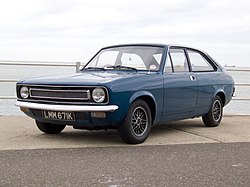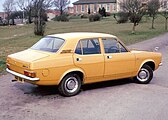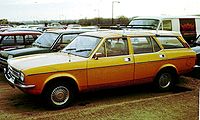Morris Marina
| Morris | |
|---|---|
|
Morris Marina Coupé (1971-1975)
|
|
| Marina | |
| Production period: | 1971-1980 |
| Class : | Middle class |
| Body versions : | Sedan , hatchback , station wagon , van , pickup |
| Engines: |
Otto engines : 1.3–1.8 liters (43–71 kW) Diesel engine : 1.5 liters (37 kW) |
| Length: | 4150-4320 mm |
| Width: | 1650 mm |
| Height: | 1410-1440 mm |
| Wheelbase : | 2440 mm |
| Empty weight : | 868-985 kg |
| Previous model |
Morris Oxford VI Morris Minor |
| successor | Morris Ital |
The Morris Marina ( ADO28 / ADO73 ) is a car model produced by British Leyland Motor Corporation (BLMC) from April 1971 to October 1980 .
After a facelift in the fall of 1980, the vehicles were sold as Morris Ital until the end of 1984 . The technical basis was the Morris Minor from 1948 until the end .
Model history
In the 1960s, the British automotive industry was faced with critical developments. The various local manufacturers merged into larger units. In 1968, under pressure from the government, the remaining larger companies British Motor Holdings (BMH: Austin, Morris and Jaguar, among others), Rover and Leyland Motors merged to form the BLMC. The technically advanced, but expensive to produce ADO-16 models (Austin 1100 ff.) Appeared in 1962, were selling increasingly poorly and a successor had not yet been developed. In addition, they could be sold to private buyers, but the simple Ford Cortina dominated the company fleets that were important on the British market. BLMC wanted to counter this with its own model, but had hardly any funds for development. So that BLMC could seriously compete with Ford and GM, the new model could not be more expensive than their offers. Therefore, already existing components were used. Development took 18 months. Roy Haynes, who was poached by Ford, had directed them. The Morris Minor from 1948 formed the basis , the transmission came from the Triumph Dolomite . The use of parts from various older models had a negative impact on production capacity and increased costs. The marina was only intended as an interim solution and was to be replaced by a new development from 1977. The marina was only marketed under the Morris brand in the UK.
The appearance of the new body was in line with the zeitgeist, but the car was technically out of date when it was first sold. The chassis with double wishbones at the front - the design with torsion bar springs and lever shock absorbers as the upper wishbones was taken from the Morris Minor - and the rigid, driven rear axle with leaf springs was inadequate for the larger car and only inadequately matched. The Marina has come under fire mainly because of its severe understeer. This problem was counteracted with a torsion bar on the rear axle.
The model was manufactured and sold in Australia (from 1972 to 1975) and in South Africa (from 1975 to 1978) as Leyland Marina and with other engines (including a 2.6-liter engine).
Facelift
Because of the planned new development, the model was initially built unchanged from the outside. From the end of 1975 the slightly modified car was called "Marina II".
Mumford Marina Convertible
The British car body manufacturer Crayford Engineering produced from 1974 on behalf of the Plymouth- based BLMC dealer W. Mumford Ltd. a two-door Marina convertible based on the Marina hatchback and sold as the Mumford Marina Convertible .
The vehicle had four full seats, as the back seat of the standard Marina was taken over unchanged. It was advertised as the "Family Convertible". To stabilize the body, Crayford built a wide roll bar into which - similar to the Bristol 412 , which was presented at the same time - small side windows were integrated. Behind the roll bar were further side windows that could be lowered using a hand crank. The sideline appeared restless overall due to this strong subdivision of the windows. The roof was operated by hand; the process of opening the roof was described as uncomplicated in a test in 1974. When closed, the top followed the roof line of the two-door coupé.
successor
The development of the successor with the code name ADO77 began in 1974. But when BLMC had to file for bankruptcy the following year, work on the ADO77 was stopped. Instead, given the limited financial resources, the marina was initially only equipped with new engines.
In October 1980 the Marina II received a major facelift , wrongly attributed to Giorgetto Giugiaro , and a new name: Morris Ital . But in view of the outdated technology, the Ital had nothing to oppose the Cortina IV / V from 1976/79 or the Vauxhall Cavalier from 1981. At the end of 1984 production finally ended after more than 807,000 units (Marina and Ital) had been sold in Great Britain alone.
Like hardly any other vehicle, the Morris Marina and the Austin Allegro, which was designed at the same time, became synonymous in Great Britain (and not only there, important export markets had long since suffered a drop in sales) for poor or widely dispersed build quality, outdated technology, excessively long production periods and short-sighted management decisions. All of this was responsible for the great image problem facing the British automotive industry. The Marina (and Ital) was the last model under the Morris name - the silent end of the once cherished brand name was sealed.
The Austin Montego , introduced in early 1984, can be seen as the successor to the Marina and Ital.
Trivia
During the production of the British television program Top Gear , four copies have been allegedly accidentally destroyed (three of them by pianos “falling from the sky”), each time leading to protests from the Marina Owners Club.
Web links
- Model history on the website www.aronline.co.uk
- German-language sales brochure for the Morris Marina II from 1978
Individual evidence
- ↑ Leyland Marina , in autocade.net.
- ↑ Autocar of September 21, 1974, p. 44 ff.
- ↑ Detailed description of the Mumford Marina Convertible on the website www.uniquecarsandparts.com.au







